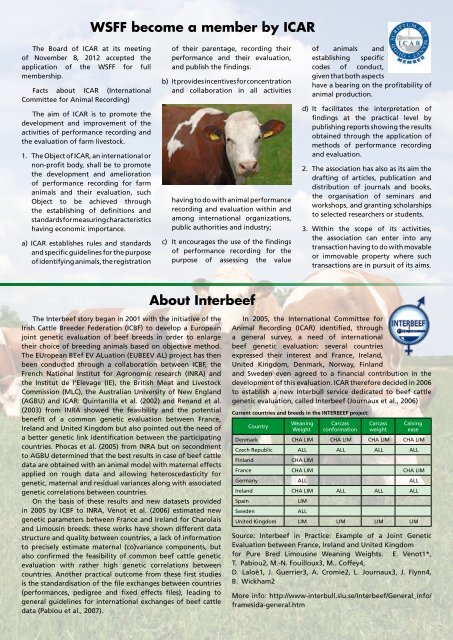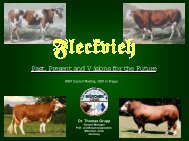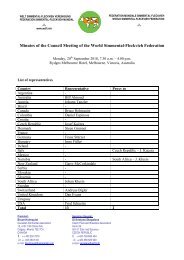By Bruce Holmquist - World Simmental Fleckvieh Federation
By Bruce Holmquist - World Simmental Fleckvieh Federation
By Bruce Holmquist - World Simmental Fleckvieh Federation
You also want an ePaper? Increase the reach of your titles
YUMPU automatically turns print PDFs into web optimized ePapers that Google loves.
The Board of ICAR at its meeting<br />
of November 8, 2012 accepted the<br />
application of the WSFF for full<br />
membership.<br />
Facts about ICAR (International<br />
Committee for Animal Recording)<br />
The aim of ICAR is to promote the<br />
development and improvement of the<br />
activities of performance recording and<br />
the evaluation of farm livestock.<br />
1. The Object of ICAR, an international or<br />
non-profit body, shall be to promote<br />
the development and amelioration<br />
of performance recording for farm<br />
animals and their evaluation, such<br />
Object to be achieved through<br />
the establishing of definitions and<br />
standardsformeasuringcharacteristics<br />
having economic importance.<br />
a) ICAR establishes rules and standards<br />
and specific guidelines for the purpose<br />
of identifying animals, the registration<br />
WSFF become a member by ICAR<br />
About Interbeef<br />
The Interbeef story began in 2001 with the initiative of the<br />
Irish Cattle Breeder <strong>Federation</strong> (ICBF) to develop a European<br />
joint genetic evaluation of beef breeds in order to enlarge<br />
their choice of breeding animals based on objective method.<br />
The EUropean BEef EV ALuation (EUBEEV AL) project has then<br />
been conducted through a collaboration between ICBF, the<br />
French National Institut for Agronomic research (INRA) and<br />
the Institut de l‘Elevage (IE), the British Meat and Livestock<br />
Commission (MLC), the Australian University of New England<br />
(AGBU) and ICAR: Quintanilla et al. (2002) and Renand et al.<br />
(2003) from INRA showed the feasibility and the potential<br />
benefit of a common genetic evaluation between France,<br />
Ireland and United Kingdom but also pointed out the need of<br />
a better genetic link identification between the participating<br />
countries. Phocas et al. (2005) from INRA but on secondment<br />
to AGBU determined that the best results in case of beef cattle<br />
data are obtained with an animal model with maternal effects<br />
applied on rough data and allowing heteroscedasticity for<br />
genetic, maternal and residual variances along with associated<br />
genetic correlations between countries.<br />
On the basis of these results and new datasets provided<br />
in 2005 by ICBF to INRA, Venot et al. (2006) estimated new<br />
genetic parameters between France and Ireland for Charolais<br />
and Limousin breeds: these works have shown different data<br />
structure and quality between countries, a lack of information<br />
to precisely estimate maternal (co)variance components, but<br />
also confirmed the feasibility of common beef cattle genetic<br />
evaluation with rather high genetic correlations between<br />
countries. Another practical outcome from these first studies<br />
is the standardisation of the file exchanges between countries<br />
(performances, pedigree and fixed effects files), leading to<br />
general guidelines for international exchanges of beef cattle<br />
data (Pabiou et al., 2007).<br />
of their parentage, recording their<br />
performance and their evaluation,<br />
and publish the findings.<br />
b) Itprovidesincentivesforconcentration<br />
and collaboration in all activities<br />
having to do with animal performance<br />
recording and evaluation within and<br />
among international organizations,<br />
public authorities and industry;<br />
c) It encourages the use of the findings<br />
of performance recording for the<br />
purpose of assessing the value<br />
In 2005, the International Committee for<br />
Animal Recording (ICAR) identified, through<br />
a general survey, a need of international<br />
beef genetic evaluation: several countries<br />
expressed their interest and France, Ireland,<br />
United Kingdom, Denmark, Norway, Finland<br />
and Sweden even agreed to a financial contribution in the<br />
development of this evaluation. ICAR therefore decided in 2006<br />
to establish a new Interbull service dedicated to beef cattle<br />
genetic evaluation, called Interbeef (Journaux et al., 2006)<br />
Current countries and breeds in the INTERBEEF project:<br />
Country<br />
Weaning<br />
Weight<br />
Carcass<br />
conformation<br />
Carcass<br />
weight<br />
Calving<br />
ease<br />
Denmark CHA LIM CHA LIM CHA LIM CHA LIM<br />
Czech Republic ALL ALL ALL ALL<br />
Finland CHA LIM<br />
France CHA LIM CHA LIM<br />
Germany ALL ALL<br />
Ireland CHA LIM ALL ALL ALL<br />
Spain LIM<br />
Sweden ALL<br />
of animals and<br />
establishing specific<br />
codes of conduct,<br />
given that both aspects<br />
have a bearing on the profitability of<br />
animal production.<br />
d) It facilitates the interpretation of<br />
findings at the practical level by<br />
publishing reports showing the results<br />
obtained through the application of<br />
methods of performance recording<br />
and evaluation.<br />
2. The association has also as its aim the<br />
drafting of articles, publication and<br />
distribution of journals and books,<br />
the organisation of seminars and<br />
workshops, and granting scholarships<br />
to selected researchers or students.<br />
3. Within the scope of its activities,<br />
the association can enter into any<br />
transaction having to do with movable<br />
or immovable property where such<br />
transactions are in pursuit of its aims.<br />
United Kingdom LIM LIM LIM LIM<br />
Source: Interbeef in Practice: Example of a Joint Genetic<br />
Evaluation between France, Ireland and United Kingdom<br />
for Pure Bred Limousine Weaning Weights. E. Venot1*,<br />
T. Pabiou2, M.-N. Fouilloux3, M.. Coffey4,<br />
D. Laloë1, J. Guerrier3, A. Cromie2, L. Journaux3, J. Flynn4,<br />
B. Wickham2<br />
More info: http://www-interbull.slu.se/Interbeef/General_info/<br />
framesida-general.htm




